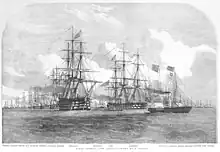HMS Wellington (1816)
HMS Wellington was a 74-gun third rate ship of the line of the Royal Navy, launched on 21 September 1816 at Deptford Dockyard.[1]
_(note-_too_many_ships_to_fit_in_the_title_field)_RMG_J3307.png.webp) Wellington | |
| History | |
|---|---|
| Name | HMS Hero |
| Builder | Deptford Dockyard |
| Laid down | July 1813 |
| Launched | 21 September 1816 |
| Renamed | HMS Wellington, 4 December 1816 |
| Fate | Sold, 1908 |
| General characteristics [1] | |
| Class and type | Vengeur-class ship of the line |
| Tons burthen | 1756 bm |
| Length | 176 ft (54 m) (gundeck) |
| Beam | 47 ft 6 in (14.48 m) |
| Depth of hold | 21 ft (6.4 m) |
| Propulsion | Sails |
| Sail plan | Full-rigged ship |
| Armament |
|
The ship had originally been named HMS Hero, but was renamed Wellington on 4 December 1816. She became a training ship in 1862, and Wellington was eventually sold out of the Navy in 1908.[1]
In 1826, HMS Wellington introduced mosquitos to the Hawaiian islands. These mosquitoes were introduced to a stream on Maui when sailors seeking fresh water rinsed out their water barrels in the stream. Prior to this, no mosquitoes lived in Hawaii.[2]

Fate
Wellington was converted to a training ship and named Akbar on 10 May 1862. In January 1877, she was driven ashore at Rock Ferry, Cheshire. She was refloated on 4 January.[3] Akbar served in as a training ship until 1908. She arrived at Thos. W. Ward, Morecambe on 8 April 1908 for breaking up.
Notes
- Lavery (2003), p.189.
- Patterson, Gordon (6 April 2009). The Mosquito Crusades: A History of the American Anti-Mosquito Movement from the Reed Commission to the First Earth Day. Rutgers University Press. ISBN 9780813547008. Retrieved 5 April 2011.
- "Latest Shipping Intelligence". The Times. No. 28832. London. 6 January 1877. col F, p. 7.
References
- Lavery, Brian (2003). The Ship of the Line - Volume 1: The development of the battlefleet 1650-1850. Conway Maritime Press. ISBN 0-85177-252-8.